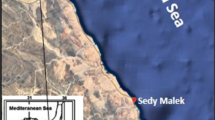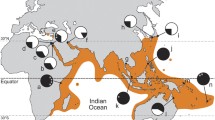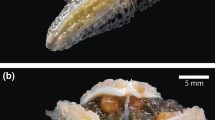Abstract
Gonad indices for two species of Diadema and two species of Echinothrix, including two color morphs of Echinothrix calamaris, are described for a 12-month period on Sosoikula Reef and Nukubuco Reef, Viti Levu, Fiji. Seasonal fluctuations in salinity (36.11±0.88 ppt) and water temperature (26.35±0.91°C) occurred. Gonad index data showed monthly reproductive rhythms, closely attuned to the lunar cycle. Diadema savignyi and Echinothrix diadema spawned on the full moon, and Diadema setosum and E. calamaris (white and brown color morphs) spawned on the new moon. Breeding periodicities coincided with the spring tides, thus maximizing chances of fertilization and dispersal. Such breeding cycles indicate how closely related species can co-exist with minimum risk of hybridization. Unusual sex ratios were found for all species, with an exceptionally low incidence of males. Reasons for this deviation from the typically reported 1:1 sex ratio may relate to the exceptionally high levels of tributyltin (TBT) recorded in Suva Harbor.








Similar content being viewed by others
References
Alizieu C, Heral M, Thibaud Y, Dardignac MJ, Feuillet M (1982) Influence des peintures antisalissures a base d’ organostanniques sur la calcification de la coquille de l’ huitre Crassostrea gigas. Rev Trav Instpeches Marit 45:101–116
Bauer JC (1976) Growth, aggregation and maturation in the echinoid, Diadema antillarum. Bull Mar Sci 26:273–276
Clark HL (1925) A catalogue of the recent sea-urchins (Echinoidea) in the collection of the British Museum (Natural History). The British Museum, London, pp 1–250
Clark AM (1966) Echinoderms from the Red Sea, Part 2 (crinoids, ophuroids, echinoids and more asteroids). Sea Fisheries Research station. Haifa Bull 41:26–58
Clark AM, Owen HG (1965) Eucidaris Pomel, 1883, Papula Bayle, 1878, Cidaris papillataconoidea Parkinson 1811 and Cidaris savignyi Audouin, 1826, proposed suppression; coupled with validation of Eucidaris Dorderlin, 1887, Stereocidaris Pomel, 1883 and Diadema savignyi Michelin, 1885, (Class Echinoidea) Z.N. 1705. Bull Zool Nom 22(4):237–242
Coppard SE (2002) Morphological and ecological differences between species of the echinoid genera Diadema and Echinothrix. Ph.D. thesis, University of London, p 466
Coppard SE, Campbell AC (2004) Taxonomic significance of spine morphology in the echinoid genera Diadema and Echinothrix. Invert Biol 123(4):357–371
Dambach M (1969) Die Reaktion de Chromatophoren des Seeigels Centrostephanus longispinus. Auf Licht Z vergl Physiol 64:400–406
Drummond AE (1991) Reproduction of the sea urchin Stomopneustes variolaris (Lam.) on the east coast of South Africa. Int J Invert Repro Dev 20(3):259–266
Drummond AE (1994) Aspects of the life history biology of three species of sea urchin on the South African east coast. In: David B, Guille A, Feral JP, Roux M (eds) Echinoderms through time. Balkema, Rotterdam, pp 637–641
Drummond AE (1995) Reproduction of the sea urchins Echinometra mathaei and Diadema savignyi on the South African Eastern coast. Mar Freshwater Res 46:751–715
Fox HM (1923) Lunar periodicity in reproduction. Proc Roy Soc 95B:523–550
Fox HM (1957) The moon and life. Proc Roy Inst Great Britain 36(2):310–332
Fuji A (1960) Studies on the biology of the sea urchin I. Superficial and histological gonadal changes in gametogenic process of two sea urchins, Strongylocentrotus nudus and S. intermedius. Bull Fac Fish Hokkaido Univ 11:1–14
Gibbs PE, Pascoe PL, Bryan GW (1991) Tributyltin-induced imposex in stenoglossan gastropods; pathological effects on the female reproductive system. Comp Biochem Physiol 100:231–235
Gosliner TM, Behrens DW, Williams GC (1996) Coral Reef Animals of the Indo-Pacific. Animal life from Africa to Hawaii exclusive of the vertebrates. Sea Challengers, Monterey, California, p 272
Grant A, Tyler PA (1983) The analysis of data in studies of invertebrate reproduction. I. Introduction and statistical analysis of gonad indices and maturity indices. Int J Invert Reprod 6:259–269
Grygier MJ (1996) A world list of coral reef-associated ascothoracida (Crustacea), with remarks on Lauridae, Petrarcidae, and Dendrogastridae from Okinawa, Japan. Galaxea 13:15–33
Halberg F, Shankariah K, Giese AC (1987) The chronobiology of marine invertebrates: methods of analysis. In: Reproduction of marine invertebrates, General aspects: seeking unity in Diversity, vol IX. Blackwell Sci Publ Palo Alto/ Boxwood press, Pacific Grove, pp 331–384
Harvey EB (1947) Bermuda sea urchins and their eggs. Biol Bull 93:217–218
Harvey EB (1956) Sex in sea urchins. Publ Staz Zool Napoli 28:127–135
Hori R, Phang VPE, Lam TJ (1987) Preliminary study on the pattern of gonadal development of the sea urchin Diadema setosum off the coast of Singapore. Zool Sci 4:665–673
Ikeda H (1931) A biometric study of the sexual dimorphism and sex ratio in Temnopleurus toreumaticus (Klein). Annot Zool Japan 13:233–242
Iliffe TM, Pearse JS (1982) Annual and lunar reproductive rhythms of the sea urchin Diadema antillarum (Phillipi) in Bermuda. Int J Invert Repro 5:139–148
Kennedy B, Pearse JS (1975) Lunar synchronisation of the monthly reproductive rhythm in the sea urchin Centrostephanus coronatus. J Exp Mar Biol Ecol 17:323–331
Kobayashi N (1967) Spawning periodicity of sea urchins at Seto. I. Mespilia globulus. Publs. Seto Mar Biol Lab 14:403–414
Kobayashi N, Nakamura K (1967) Spawning periodicity of sea urchins at Seto. II. Diadema setosum. Publs Seto Mar Biol Lab 15:173–184
Lessios HA (1981) Reproductive periodicity of the echinoids Diadema and Echinometra on the two coasts of Panama. J Exp Mar Biol Ecol 50:47–61
Lessios HA (1984) Annual reproductive periodicity in eight echinoid species on the Caribbean coast of Panama. In: Proceedings of 5th international echinoderm conference, pp 24–29
Lessios HA, Pearse JS (1996) Hybridization and introgression between Indo-Pacific species of Diadema. Mar Biol 126:715–723
Lewis JB (1966) Growth and breeding in the tropical echinoid Diadema antillarum Philippi. Bul Mar Sci 16:151–158
Maata M (1998) TBT levels in Suva Harbor, Fiji. In: Paints change snail sex. Fiji Times, McCutchan A, p 38
Maata M, Koshy K (2001) A study of tributyltin contamination of marine sediments in the major ports of Fiji. South Pacific J Nat Sci 19:1–4
Macnae W, Kalk M (1958) A natural history of Inhaca Island, Mozambique 9 pls. Witwatersrand University Press: Johannerburg, p 163
Martin MG, Moschino V, Cima F, Celli C 2000 Embryotoxicity of butyltin compounds to the sea urchin Paracentrotus lividus. Mar Environ Res 50:231–235
McPherson BF (1965) Contributions to the biology of the sea urchin Tripneustes ventricosus. Bull Mar Sci 15:228–244
Metz EC, Kane RE, Yanagimachi H, Palumbi SR (1994) Fertilization between closely related sea urchins is blocked by incompatibilities during sperm-egg attachment and early stages of fusion. Biol Bull 187:23–34
Moore HB, Jutare T, Bauer JC, Jones JA (1963a) The biology of Lytechinus variegatus. Bull Mar Sci 13:23–53
Moore HB, Jutare T, Jones JA, Mcpherson BF, Roper CFE (1963b) A contribution to the biology of Tripneustes esculentus. Bull Mar Sci 13:267–281
Mortensen T (1937) Contributions to the study of the development and larval forms of echinoderms III. K danske Videnske Selke. Skr Naturv Math Ser 9(7)1:1–65
Mortensen T (1940) Monograph of the Echinoidea. III (1), C.A. Reitzel., Copenhagen, pp 1–370
Nichols D (1984) An investigation of the population dynamics of the common edible sea urchin (Echinus esculentus L.) in relation to species conservation management. Report to Department of the Environment and Nature Conservancy Council from the Department of Biological Sciences, University of Exeter, p 17
Novelli AA, Argese E, Tagliapietra D, Bettiol C, Ghirardini AV (2002) Toxicity of tributyltin and triphenytin to early life-stages of Paracentrotus lividus (Echinodermata: Echinoidea). Environ Tox Chem 21(4):859–864
Orton JH (1923) The breeding period of Echinus miliaris. Nature 111:878–879
Ozretic B, Petrovic S, Krajnovic-Ozretic M (1998) Toxicity of TBT-based paint leachates on the embryonic development of the sea urchin Paracentrotus lividus Lam. Chemosphere 37:1109–1118
Pawson DL, Miller JE (1982) Studies of genetically controlled phenotypic characters in laboratory-reared Lytechinus variegates (Lamarck) from Bermuda and Florida (Echinodermata: Echinodea). In: Lawrence JM, Balkema AA (ed) Echinoderms: Proceedings of international echinoderm conference, Tampa Bay. Rotterdam, pp 165–172
Pearse JS (1968) Patterns of reproductive periodicities in four species of Indo-Pacific echinoderms. Proc Ind Acad Sci 67B(6):247–279
Pearse JS (1969a) Reproductive periodicities of Indo-Pacific invertebrates in the Gulf of Suez. I. The echinoids Prionocidaris baculosa (Lamarck) and Lovenia elongata (Gray). Bull Mar Sci 19:323–350
Pearse JS (1969b) Reproductive periodicities of Indo-Pacific invertebrates in the Gulf of Suez. II. The echinoid Echinometra mathaei (De Blainville). Bull Mar Sci 19:580–613
Pearse JS (1970) Reproductive periodicities of Indo-Pacific invertebrates in the Gulf of Suez III. The echinoid Diadema setosum (Leske). Bull Mar Sci 20:697–720
Pearse JS (1972) A monthly reproductive rhythm in the diadematid sea urchin Centrostephanus coronatus Verrill. J Exp Mar Biol Ecol 8:167–186
Pearse JS (1975) Lunar reproductive rhythms in sea urchins. A review. J Interdiscipl Cycle Res 6(1):47–52
Pearse JS, Cameron AR (1991) Echinodermata: Echinoidea. In: Giese AC, Pearse JS, Pearse VB (eds) Reproduction of marine invertebrates, vol VI. Echinoderms and Lophophores Boxwood Press, Pacific Grove, California, pp 513–662
Pillay KK (1971) The breeding season of the sea urchin, Stomopneustes variolaris from the southwest coast of India. J Kerala Acad Biol 3:44–47
Randall JE, Schroeder RE, Starck WA (1964) Notes on the echinoid Diadema antillarum. Carib J Sci 4:421–433
Riginos C, McDonald JH (2003) Positive selection on the acrosomal sperm protein, M7 Lysin, in three species of the genus Mytilus. Mol Biol Evol 20(2):200–207
Ringwood AH (1992) Comparative sensitivity of gametes and early development stages of a sea urchin species (Echinometra mathaei) and a bivalve species Isognomon californicum) during metal exposure. Arch Environ Contam Toxicool 22:288–295
Ruiz JM, Bryan GW, Gibbs PE (1994) Chronic toxicity of water tributyltin (TBT) and copper to spat of the bivalve, Scrobicularia plana; ecological implications. Mar Ecol Prog Ser 113:105–117
Stephenson A (1934) The breeding of reef animals. Part II. invertebrates other then corals. Gt. Barrier Reef Exped., 1928-1929. Sci Rep 3:247–272
Swann MM (1954) Secondary sex differences in five European species of sea-urchin. Publ Staz Zool Napoli 25:198–200
Tahara Y, Okada M, Kobayashi N (1958) Secondary sexual characters in Japanese sea- urchins. Publ Seto Mar Biol Lab 7:165–172
Tahara Y, Okada M, Kobayashi N (1960) Further notes on the sexual dimorphism in Japanese sea urchins. Publ Seto Mar Biol Lab 8:183–189
Tuason AY, Gommez ED (1979) The reproductive biology of Tripneustes gratilla Linnaeus (Echinodermata: Echinoidea), with some notes on Diadema setosum Leske. In: Proceedings of international symposium Mar Biogeogr Evol So Hemisphere, Auckland, New Zealand, 17-20 July 1978. 2:707–716
Tyler A, Tyler BS (1966) The gametes: some procedures and properties. In: Physiology of Echinodermata, pp 639–682
Uehara T, Asakura H, Arakaki Y (1990) Fertilization blockage and hybridization among species of sea urchins. In: Hoshi M, Yamashita O (eds) Advances in invertebrate reproduction. Elsevier, Amsterdam, pp 305–310
Yonge CM (1940) The biology of reef building corals. Sci Rep Gt Barrier Reef Exped 1(13):353–389
Yoshida M (1952) Some observations on the maturation of the sea urchin Diadema setosum. Annotnes Zool Jap 25:265–271
Yoshida M (1966) Photosensitivity. In: Boolootian RA (ed) Physiology of Echinodermata. Interscience Publ, New York, pp 435–464
Acknowledgements
We would like to thank Peter Newell and Robin South for their assistance at the University of the South Pacific. We are grateful to Shirley Mohammed-Coppard for her help in collecting and dissecting specimens, John Pearse for his advice, and Maurice Elphick for his comments on the manuscript.
Author information
Authors and Affiliations
Corresponding author
Additional information
Communicated by Editor R.E. Dodge
Rights and permissions
About this article
Cite this article
Coppard, S.E., Campbell, A.C. Lunar periodicities of diadematid echinoids breeding in Fiji. Coral Reefs 24, 324–332 (2005). https://doi.org/10.1007/s00338-005-0491-5
Received:
Accepted:
Published:
Issue Date:
DOI: https://doi.org/10.1007/s00338-005-0491-5




